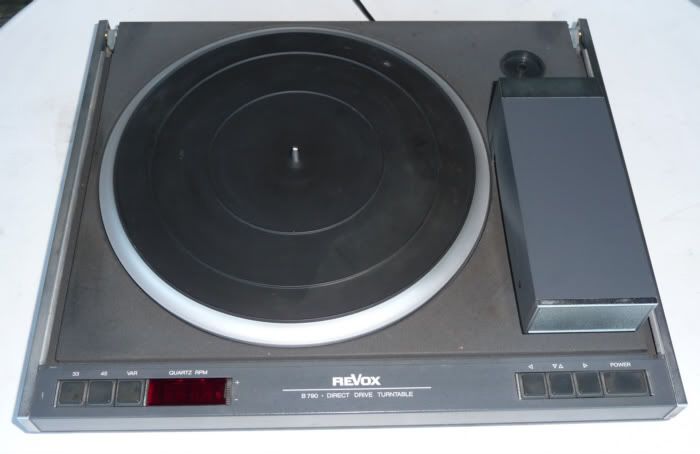Revox B 795 TT
A friend was moving and hadn't unpacked this TT in over 10 years. He not only gave me his similarly unused B&W DM-3000s but also threw in his Revox B 795. I've finally unpacked it but the flat black vinyl covering on the base seems to have turned into a sticky mess that stuck to the Styrofoam packing material. Regardless, it still seems to turn and function mechanically although the platter seems to need a hand assist to begin spinning. Once it spins, it continues and seems stable.
All I've done is clean the arm rails with alcohol.
It came with some type of Grado that looks remarkably like my old, Grado, Signature 8MX. Can't really identify which model without taking it out of that imposing tangential/linear tracking arm.
In the box was also an old unmounted Dynavector 10x3 with original purchase receipt (purchased in 1982) but the stylus seems to have very little diamond left (it's very, very tiny). Pics and a review to come but it may be a couple of weeks. Also, I seem to have all the Revox literature that would have normally come with the 795.
A friend was moving and hadn't unpacked this TT in over 10 years. He not only gave me his similarly unused B&W DM-3000s but also threw in his Revox B 795. I've finally unpacked it but the flat black vinyl covering on the base seems to have turned into a sticky mess that stuck to the Styrofoam packing material. Regardless, it still seems to turn and function mechanically although the platter seems to need a hand assist to begin spinning. Once it spins, it continues and seems stable.
All I've done is clean the arm rails with alcohol.
It came with some type of Grado that looks remarkably like my old, Grado, Signature 8MX. Can't really identify which model without taking it out of that imposing tangential/linear tracking arm.
In the box was also an old unmounted Dynavector 10x3 with original purchase receipt (purchased in 1982) but the stylus seems to have very little diamond left (it's very, very tiny). Pics and a review to come but it may be a couple of weeks. Also, I seem to have all the Revox literature that would have normally come with the 795.
Last edited:





